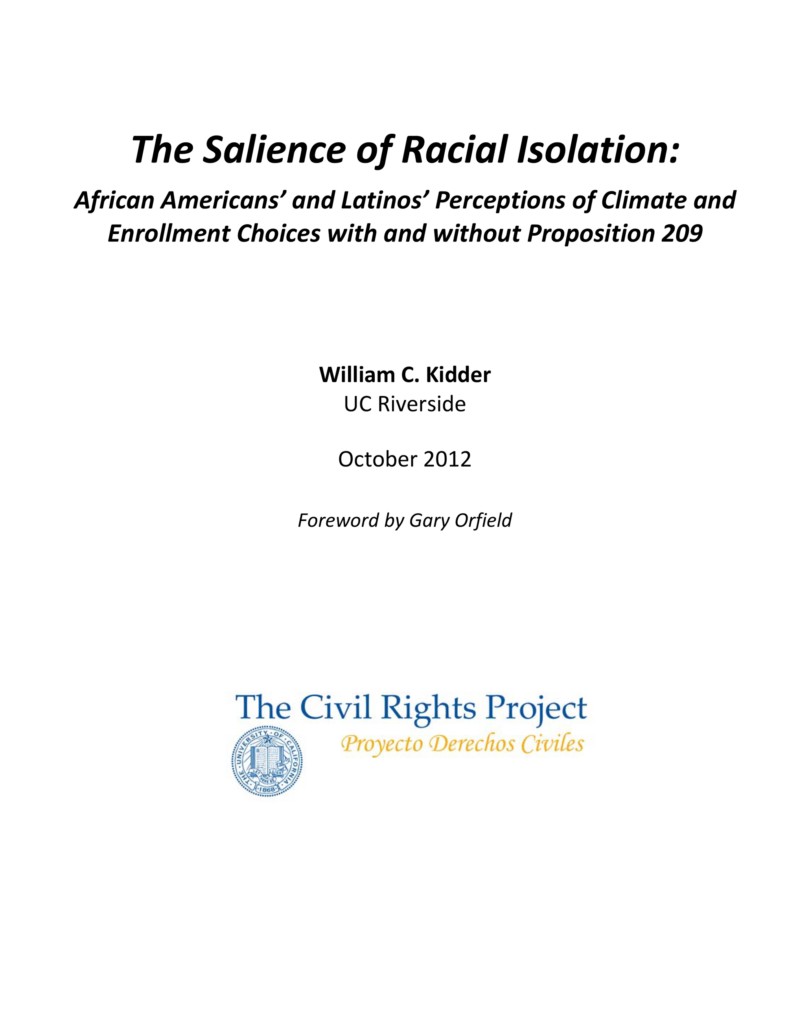Executive Summary
As noted by a number of social scientists, affirmative action bans create “natural experiments” that open possibilities for testing important questions of public policy related to racial/ethnic inequality in America. Of the various natural experiments that emerge from the discontinuation of higher education affirmative action in several states, none matter more than California’s experience under Proposition 209, the 1996 ballot initiative that changed California’s constitution and prohibited affirmative action in state education, employment and contracting as of 1998. This paper presents two sets of natural experiment data, the first addresses campus racial climate and the second addresses the enrollment choices of freshmen admitted to the University of California.
Part I utilizes an unusually large survey sample of 9,750 African American and Latino undergraduates at eight University of California campuses, the University of Texas at Austin and two other leading American research universities. These data for 2008-11 reveal that having an affirmative action ban (Prop 209) in conjunction with low diversity is associated with fewer African Americans and Latinos perceiving that students of their race/ethnicity are respected on campus compared to campuses with affirmative action and/or higher levels of diversity. At the University of California, only 62% of African Americans feel that students of their race are respected on campus, which is significantly lower than African Americans at UT Austin (72%) and at two other peer universities (75% and 76%). When separating out each campus and survey administration of the survey, in all of nearly one hundred head-to-head comparisons, the campuses with an affirmative action ban and an African American population of only four percent or less have African American undergraduates who are less likely to feel respected than those at the campuses with student bodies that are five percent or more African American (some with affirmative action and some without). Similarly, the data show that at UC, 77% of Latinos feel that students of their ethnicity are respected on campus, which is significantly lower than results for Latinos at UT Austin (90%) and is also lower than Latinos at the two other peer universities (80% and 90%). The data lend support to the concept of “critical mass” while acknowledging that context matters and it is unrealistic to expect an across-the-board numerical definition of what constitutes sufficient critical mass.
The natural experiment data at these research universities also highlight that African Americans’ and Latinos’ diminished sense of feeling respected is not inevitable; under the right conditions and with robust levels of racial/ethnic diversity African Americans and Latinos feel just as respected at research universities as other students. The data in Part I reinforce the educational importance of avoiding racial isolation in the university setting, and show that this challenge is generally worsened for African Americans and Latinos at campuses with low diversity for reasons stemming from an affirmative action ban.
While Part I analyzes what students say and believe, Part II of this paper analyzes what students do as a means of testing whether Proposition 209 had either a “chilling effect” or a “warming effect” on underrepresented minorities’ enrollment choices at UC and competitor institutions. The data also address the research question of whether Black and Latino students (especially the subset who are among the top admits) actually prefer to enroll at UC campuses after Prop 209 based on their perception that they will be less subject to “racial stigma” as compared to enrolling at elite private universities with affirmative action.
For African Americans admitted to UC, a comparison of pre-209 and post-209 freshmen data reveal that after the affirmative action ban the yield rate to UC consistently declined for African Americans whether they were in the top third of UC’s admit pool (39% to 33%), the middle third of the admit pool (61% to 50%) or the bottom third of the admit pool (64% to 52%). And data from campus-level admit pools indicate a dozen instances since 1998 where there was a zero percent yield rate for African Americans in the top of the admit pools at UC Berkeley, UC San Diego and other campuses, an event that never happened in the four years before Prop 209. After Prop 209 the yield rate to UC also consistently declined for Latinos in the top third of UC’s admit pool (52% to 48%), the middle third of the admit pool (61% to 50%) and the bottom third of the admit pool (61% to 49%).
Conversely, post-209 data for 2001-11 within the top third of UC’s admit pool reveal that 16% of whites/Asian Americans/others choose to enroll at selective private selective colleges or universities, compared to 25% for Latinos and 39% for African Americans choosing to enroll at these elite institutions that employ affirmative action. Earlier research indicates this pattern of underrepresented minorities choosing to attend private competitors instead of Berkeley, UCLA and other UC campuses became more pronounced after Prop 209 as compared to immediately before Prop 209.
The data in Part II support the “chilling effect” hypothesis and call into question other recent claims of economists who assert – without the benefit of the data on selective private universities reviewed herein – that Prop 209, by reducing stigma, brought about a mild “warming effect” in freshmen enrollment yield at UC. The data in Part I also constitutes a natural experiment that calls into question the validity of the stigma critique of affirmative action, by showing that underrepresented minority students actually feel less respected at the University of California than at peer research universities.
In compliance with the UC Open Access Policy, this report has been made available on eScholarship:
